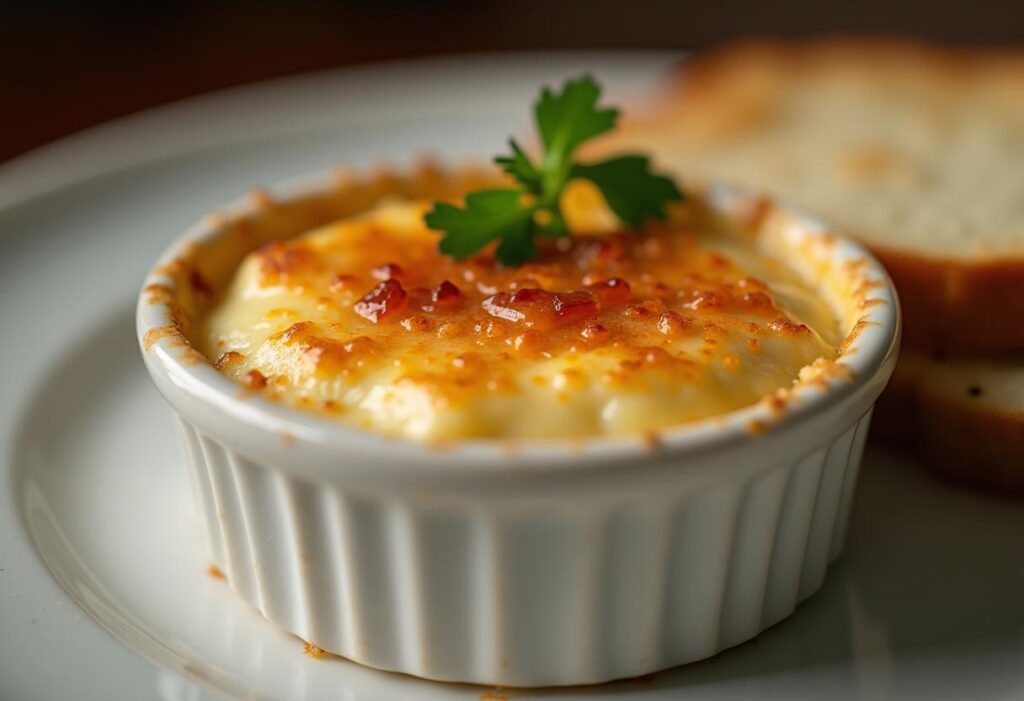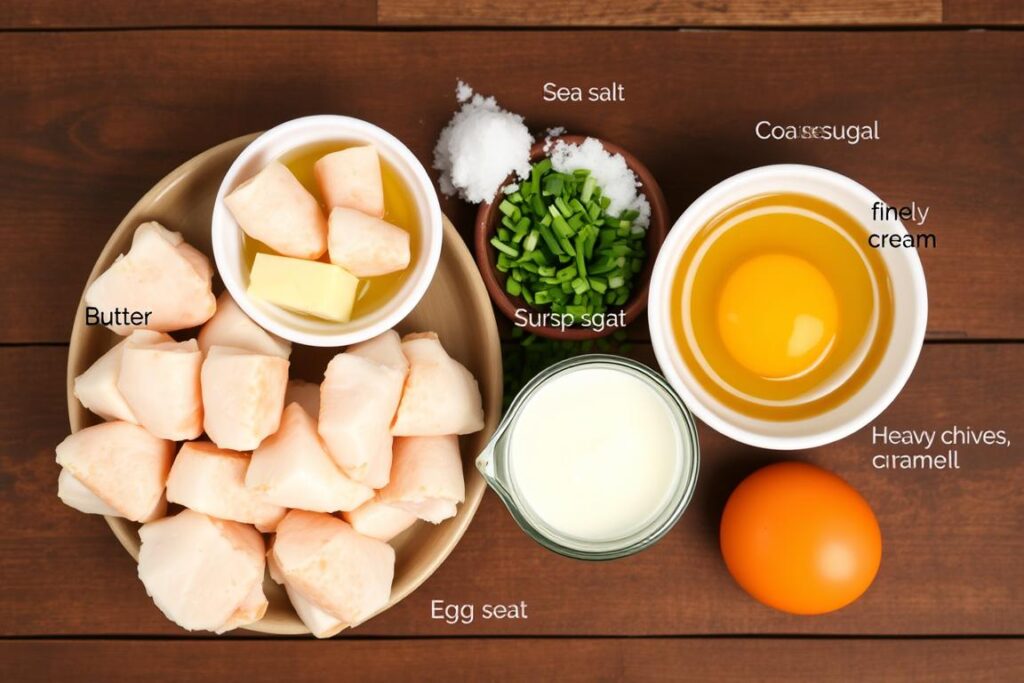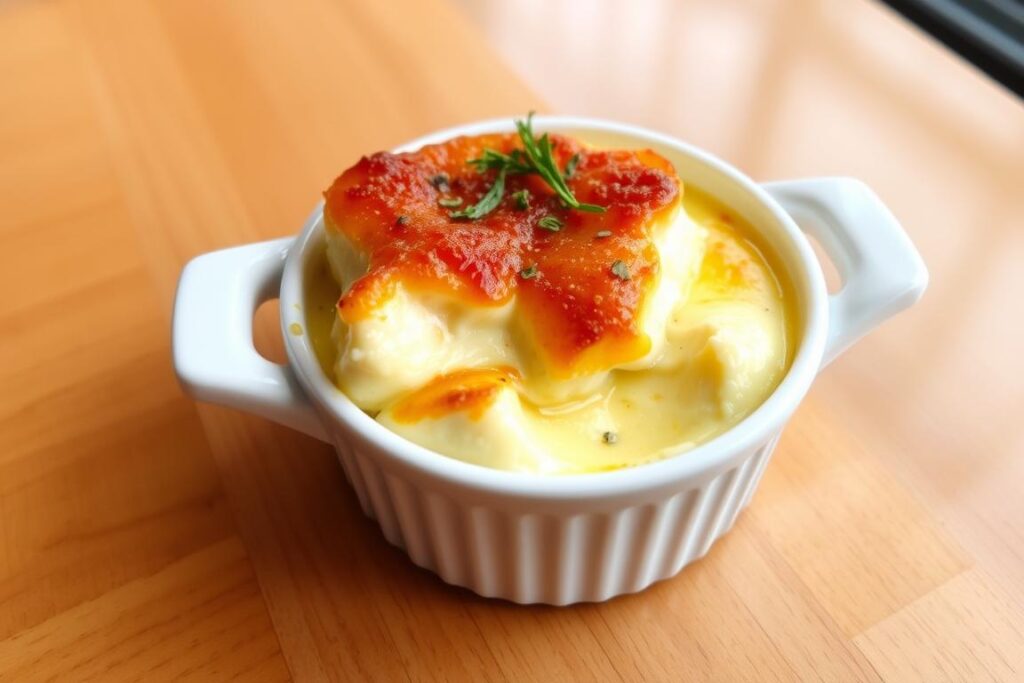
Crab brulee recipe is a delightful savory adaptation of the beloved crème brulee. Combining the creamy texture of custard with the rich, tender taste of crab, this dish strikes a perfect balance between elegance and innovation. In this article, we’ll explore the ins and outs of creating this unique seafood delicacy, from selecting the finest ingredients to achieving that signature caramelized crust. Whether you’re a seasoned chef or a home cook looking to impress, this crab brûlée recipe will guide you every step of the way.
Let’s dive into Part 1 to uncover the origins of this dish and why it’s such a showstopper.
Introduction to Crab Brulee Recipe
The Origins of Crème Brulee
Crème brulee, which translates to “burnt cream” in French, is a classic dessert that has graced tables since the 17th century. Traditionally, it’s a sweet custard topped with a caramelized sugar crust, offering a satisfying contrast of creamy and crunchy textures. It’s been a favorite in French cuisine and beyond for its simplicity and indulgence.
Introducing the Savory Variation: Crab Brulee Recipe
While the original crème brûlée is sweet, chefs worldwide have been experimenting with savory takes on this iconic dish. Savory crème brûlées have emerged as a trend, with crab brûlée stealing the spotlight. By blending fresh, succulent crab meat into the custard base and skipping the sugar for spices and herbs, this dish transforms into an elegant seafood starter. It’s perfect for dinner parties, adding a touch of sophistication and creativity to the menu.
With its creamy custard infused with the richness of crab, this variation has quickly become a favorite for those looking to break away from traditional appetizers. So, ready to make it yourself? Let’s continue by discussing the key ingredients that bring this dish to life!
Table of contents
Key Ingredients for the Crab Brulee Recipe

Choosing the Best Crab for Your Crab Brulee Recipe
The key to a successful crab brûlée recipe is high-quality crab meat. Fresh crab meat is always the best option, offering a sweet, delicate flavor that elevates the dish. If fresh crab isn’t available, you can opt for refrigerated lump crab meat, which is flavorful and easy to work with. Avoid canned crab meat, as it often lacks the rich taste and tender texture needed for this dish.
When preparing the crab, ensure it’s free of shells or cartilage. Picking over the crab meat carefully not only improves texture but also ensures every bite is smooth and enjoyable.
The Role of Cream and Eggs in Custard
At the heart of any crème brûlée lies a silky custard base. In this recipe, heavy cream and egg yolks work together to create the creamy consistency that makes this dish so luxurious. Heavy cream brings richness, while egg yolks provide structure and depth.
For the best results, use fresh cream and eggs. Combine them gently to avoid introducing air, as air bubbles can lead to an uneven texture during baking.
Seasonings and Aromatics
Seasonings are where this dish shines. A touch of nutmeg or white pepper can enhance the natural sweetness of the crab, while herbs like chives or tarragon add an aromatic freshness. A pinch of salt ties everything together, bringing balance to the custard’s rich flavors.
To give the brûlée its signature seafood twist, some recipes include a dash of seafood stock or fish sauce, enhancing the savory notes. Be cautious not to overpower the dish—subtlety is key.
Step-by-Step Preparation Guide
Preparing the Custard Base
To begin this crab brûlée recipe, start by preparing the custard base. Combine heavy cream and egg yolks in a mixing bowl, whisking gently to blend. Add seasonings such as salt, white pepper, and a hint of nutmeg.
Heat the mixture slightly in a saucepan over low heat, stirring constantly to prevent it from curdling. This step allows the flavors to meld, creating a rich, flavorful base. Let the mixture cool before proceeding to the next step.
Incorporating the Crab Meat
Once the custard base is ready, it’s time to add the crab. Gently fold the crab meat into the cooled custard mixture, being careful not to break it apart. Even distribution ensures that every bite of the brûlée contains the perfect balance of crab and custard.
At this stage, you can also add a sprinkle of finely chopped chives for added flavor and visual appeal.
Baking Techniques for Perfect Custard
The secret to achieving a smooth custard lies in the baking method. Pour the custard mixture into ramekins, filling them about three-quarters full. Place the ramekins in a deep baking dish and create a water bath by pouring hot water into the dish until it reaches halfway up the sides of the ramekins.
Bake the custards in a preheated oven at 300°F (150°C) for 30–40 minutes, or until they are set but still slightly jiggly in the center. This gentle cooking method ensures the custard remains silky and doesn’t overcook.
Achieving the Signature Caramelized Top
After the custards have cooled, it’s time for the iconic brûlée topping. Instead of sugar, this savory version can use breadcrumbs or a sprinkle of grated Parmesan cheese. Lightly torch the topping until golden and crisp, adding a delightful crunch to each bite.
With these steps, your crab brûlée recipe is ready to dazzle! Serve warm or at room temperature for the best experience.
Serving Suggestions and Pairings
Ideal Accompaniments for Crab Brulee Recipe
When serving this crab brûlée recipe, consider pairing it with sides that complement its rich, savory profile. A crisp green salad with a light vinaigrette offers a refreshing contrast, balancing the creaminess of the brûlée. Additionally, toasted baguette slices or artisanal crackers provide a satisfying crunch, enhancing the overall dining experience.
For beverage pairings, a chilled glass of Chardonnay or a light Sauvignon Blanc works wonders. The acidity in these wines cuts through the richness of the custard, creating a harmonious balance on the palate.
Presentation Tips for an Elegant Dining Experience
Presentation plays a crucial role in elevating this dish. Serve the crab brûlée in individual ramekins to add a touch of sophistication. Before serving, garnish with a sprinkle of fresh herbs like chives or parsley to introduce a pop of color and freshness.
For an added visual appeal, consider placing the ramekins on a decorative plate accompanied by lemon wedges. The citrus not only enhances the flavor but also adds a vibrant hue to the presentation.
Remember, the caramelized top should be freshly torched just before serving to maintain its delightful crunch. Encourage guests to crack through the crust to reveal the creamy custard beneath—a sensory experience that combines texture and flavor beautifully.

Common Mistakes to Avoid
Overcooking the Crab Brulee Custard
One of the most common pitfalls when making a crab brûlée recipe is overcooking the custard. If baked for too long, the texture can become grainy instead of creamy. To avoid this, keep a close eye on the custards during baking. The perfect custard should be set around the edges but slightly jiggly in the center.
Using a water bath is another essential step to prevent overcooking. The water creates a gentle, even heat that protects the custard from curdling or drying out. Skipping this step could lead to unevenly cooked brûlées.
Using Low-Quality Ingredients
Since this recipe relies heavily on the quality of its ingredients, using subpar crab meat or stale cream can greatly impact the flavor. Always opt for fresh or high-quality crab meat, and never substitute low-fat or skim cream, as this will affect the richness and texture of the custard.
I’ve included more transition words, which should help with readability. Let me know if you need further adjustments!
FAQs
What is the secret of crème brûlée?
The secret to making perfect crème brûlée, whether sweet or savory like the Crab Brulee Recipe, lies in achieving the ideal custard consistency. This balance between cream, egg yolks, and sugar (or savory additions like crab) is key to its rich, smooth texture.
What’s the difference between crème brûlée and custard?
Both crème brûlée and custard are made from similar ingredients, but the key difference is the caramelized sugar topping of crème brûlée. The Crab Brulee Recipe combines the smooth texture of custard with savory crab for a unique variation.
What type of cream is best for crème brûlée?
Heavy cream is typically the best choice for crème brûlée due to its rich, creamy texture. In the Crab Brulee Recipe, this same heavy cream helps create a decadent, smooth custard that pairs wonderfully with crab.
What does crème brûlée taste like?
Crème brûlée has a rich, creamy flavor with a slightly caramelized sugar topping. In the Crab Brulee Recipe, the sweet taste of traditional crème brûlée is replaced by the savory taste of crab, making it a delicious, unexpected twist.
For more delicious recipes and cooking inspiration, check out Recipes Nicest.
